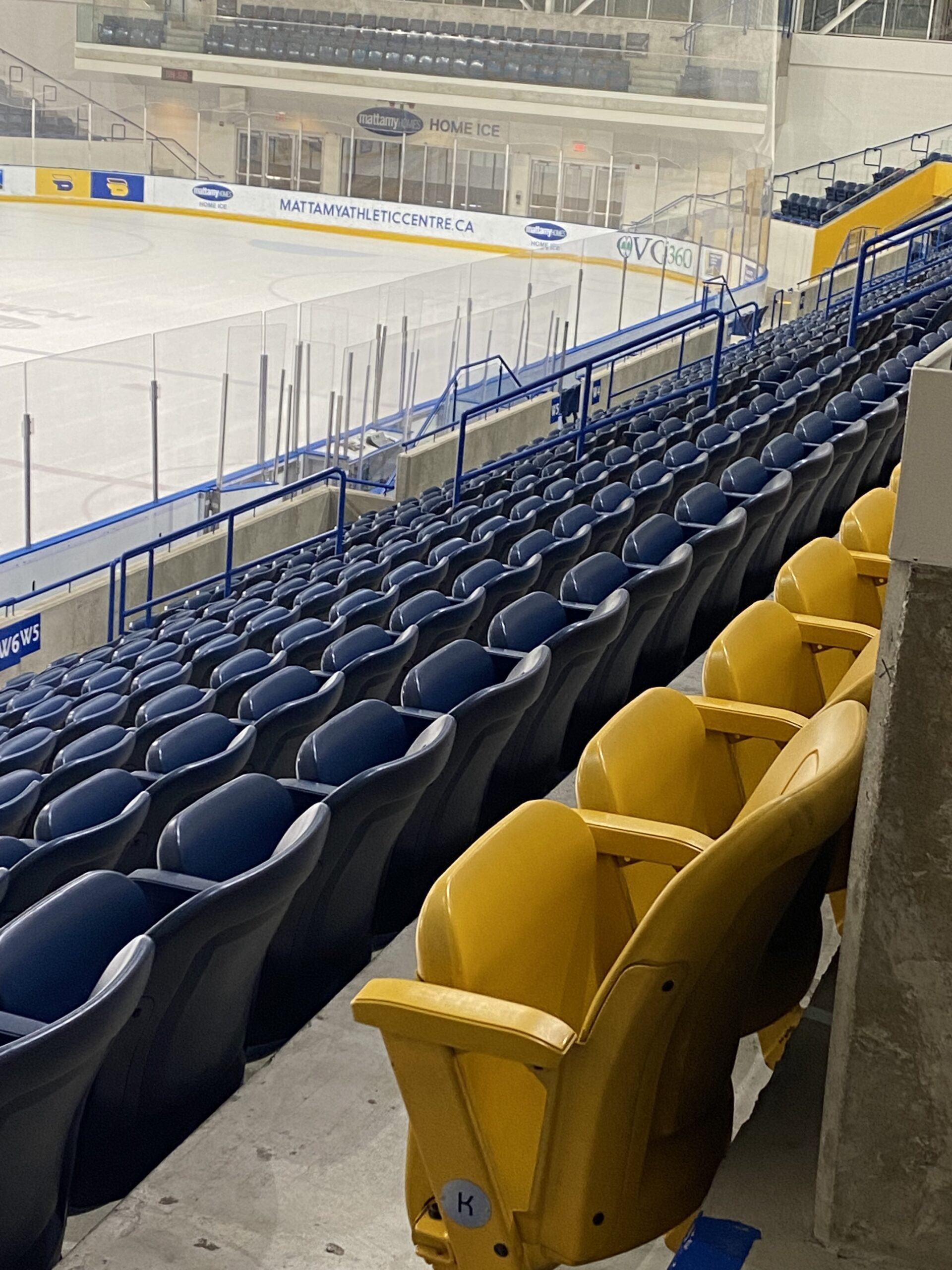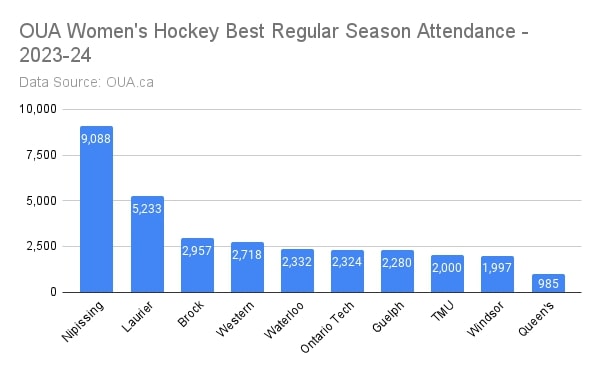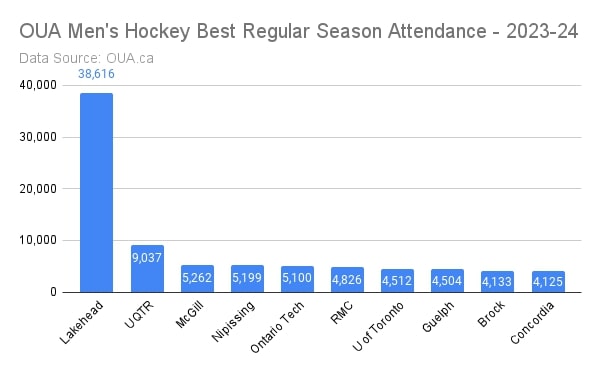
Listen to the full story here:
Varsity teams at universities across Ontario are almost all struggling to attract fans to sporting games.
Ontario University Athletics (OUA) attendance figures for this past season show that Lakehead University and Nipissing University pull in fans for varsity hockey while some other universities draw crowds for football. Most hockey, basketball and volleyball teams, however, draw just a few hundred people per game at best.
At Toronto Metropolitan University, the Bold’s varsity teams have a history of mixed success when it comes to attracting fans to sporting events.
“Before the pandemic, a lot of our teams were very, very successful. Women’s volleyball went undefeated and won nationals. Men’s basketball, in my time as a student, won nine medals in five years,” said Kevin MacDonald, who works in community engagement and events at TMU.
“Men’s hockey was always good and women’s hockey had a couple of really good years as well. Attendance was always steady because of our teams doing well.”
When the Mattamy Athletic Centre opened in 2011 after major renovations, fans and students alike flocked to Carlton Street to attend games. The men’s hockey team, for example, regularly saw more than 300 fans attend a game. The high point came in 2014-15 when the team drew 1,195 fans per game.
TMU’s teams have continued to win – with the men’s hockey team finishing as the fourth best team in the country as well as the OUA silver medalists, but post-pandemic, attendance has never recovered.
During the 2023-24 regular season, the women’s hockey team had an average of 143 fans per game with a total of 2,000 spectators over the course of the regular season.
Student attendance at men’s hockey games was better but attendance still struggled – with an average of 222 fans turning out for each of the 14 regular-season games. A total of 3,103 fans showed up for the regular season, due in large part to the homecoming game, the only event to attract more than 1,000 students.


The volleyball team has also struggled with attendance.
“It’s discouraging but not surprising,” said Niko Rukavina, interim head coach of the TMU men’s volleyball team.
“I found a couple times this year, (we were) hearing the opponents’ fans more than our own. Windsor came to play us and the Windsor crowd was louder than our crowd,” he added.
Rukavina said he didn’t have statistics but from what he saw attendance-wise this year at volleyball games, just from an eye test, it was “similar or maybe even less.”
Nick Asquini, director of sports operations for the Bold, said the university is still dealing with the pandemic’s effects.
“There’s a change in behaviour coming out of COVID that we’re still reconciling with,” he said. “I think for us specifically too, we’ve had a lot of turnover in the department so we’ve had people re-learning jobs or learning new roles.”
MacDonald identified TMU’s commuter student population and game schedules as two reasons for the attendance issues.
“We play Thursday, Friday, Saturday nights,” he said. “A big majority of the school population is commuting 30-60 minutes both ways and a lot of times, people don’t really have the desire to sit and watch a game and head home at 9:30-10:00 at night.”
Asquini also identified scheduling as an issue, noting the first week of playoffs always happens during reading week, which makes it a struggle to attract people to the Mattamy Athletic Centre because students aren’t on campus.
He said attracting students is also an issue because “we don’t have a big cluster of student apartment housing. We’re right in the downtown core at the university.”
Other universities in the GTA that have more on-campus housing, however, also struggle to draw fans.
This past season, the University of Toronto men’s hockey team saw an average of 323 fans per game while the York University’s men’s and women’s hockey teams saw an average of 79 and 50 fans respectively.
“We’re competing for the attention in a big sports market where there’s lots of things to do and an entertainment market where there’s lots of things to do,” said Dan Church, head coach of the York women’s hockey team. “That’s both a good thing and a bad thing.”
“Big events, you get big crowds and the rest of the time you get ignored,” said Russ Herrington, head coach of the York men’s hockey team. “The unfortunate part is, I think that’s par for the course across most of our league for the exception of Lakehead.”
The empty stands can be a big change for student athletes. Some men’s varsity hockey players, for example, played in the Ontario Hockey League where games can draw several thousand fans on a given night.
“For some players, I think it’s a bit of a shock to the system,” Herrington said.
Connor Bowie, a second-year forward on the TMU men’s hockey team, has spoken out about the issue.
“I just want them to come out to the games, man. Is that too much to ask?” he said in a video posted to the team’s Instagram account in January.
TMU refused to release information on how much the university spends every year on varsity teams. “Details regarding the budget for varsity sport programs at universities in the OUA and in U SPORTS are not publicly available,” said TMU Athletics and Recreation in a written response to questions. The Ontario government’s public sector salary disclosure shows that in 2022, TMU spent $620,000 on the salaries of five varsity head coaches.
TMU president Mohamed Lachemi defended the spending on varsity sports.
“Fifty-seven universities across Canada invest in campus athletics as a way to demonstrate our community and demonstrate the importance of building excellence in both the classroom and athletic competition,” Lachemi told OTR in an interview.
“We were extremely proud of our (marketing) team’s efforts,” he said, pointing to the recent men’s hockey national tournament held at the MAC. “But, as a university, we should always find a way to do better and that’s part of the discussion we’re having with our team.”
MacDonald said figuring out how to put students in seats at the Mattamy Athletic Centre is an ongoing challenge.
Setting up a table on campus to talk with students about sporting events doesn’t always work, he said.
“Unless it’s a full campus fair, people don’t always come up to a table and talk to people randomly,” he added.
MacDonald said he and his staff, including CareerBoost students, are also always looking for promotional ideas when they attend games involving other teams.
Herrington said attracting fans to York’s varsity hockey games is an ongoing effort.
“We just haven’t been able to really find the magic recipe.”
Reporter, On The Record, Winter 2024
This article may have been created with the use of AI tools such as
Reporter, On The Record, Winter 2024
